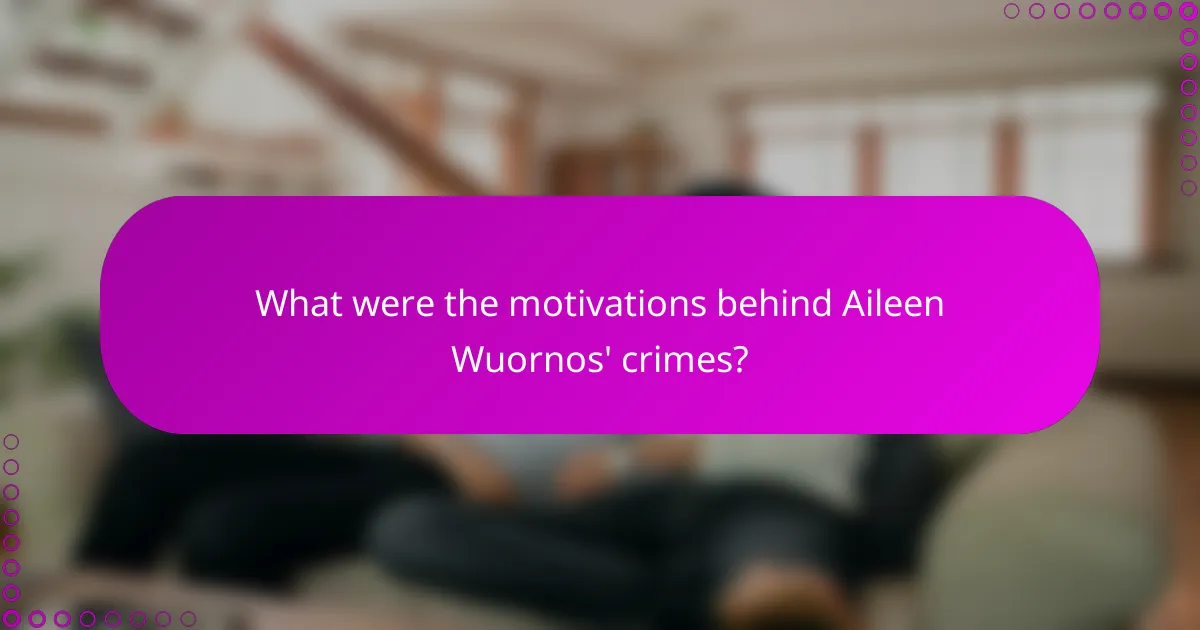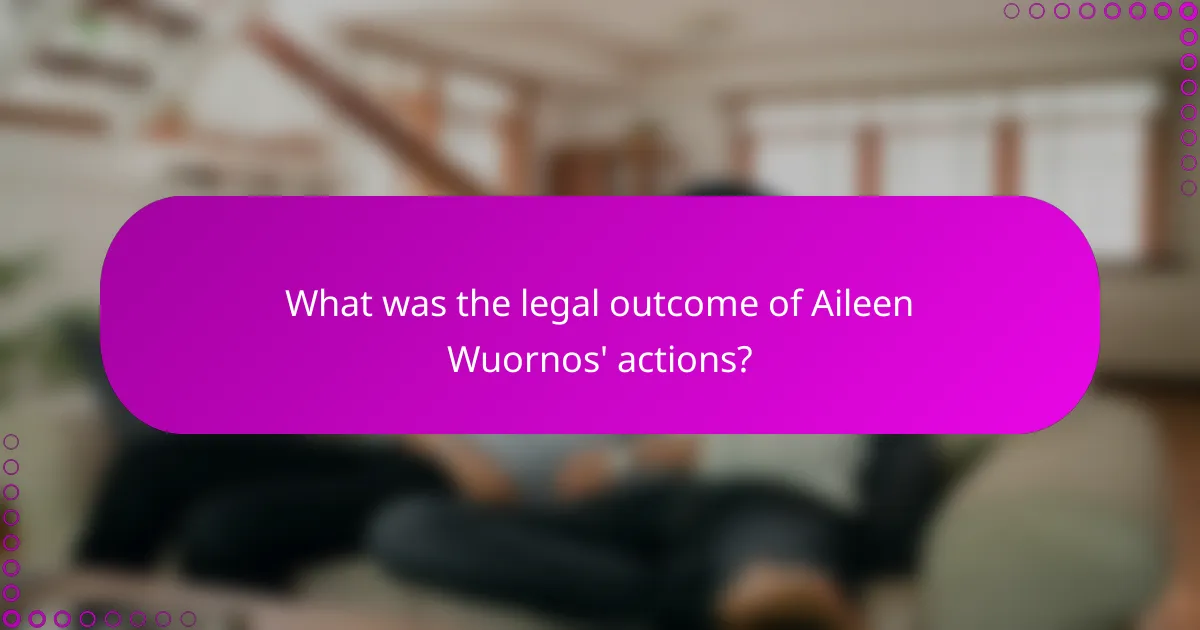Aileen Wuornos was a notorious American serial killer, born on February 29, 1956, in Rochester, Michigan. Her life was marked by trauma, including abandonment and abuse, which contributed to her involvement in crime, particularly theft and prostitution. Wuornos murdered seven men between 1989 and 1990, claiming self-defense against attempted assaults. She was arrested in 1991, diagnosed with borderline personality disorder and antisocial personality disorder, and ultimately sentenced to death. Wuornos was executed by lethal injection on October 9, 2002, a case that garnered significant media attention and raised questions about her psychological state and the judicial response to her crimes.

What are the key events in Aileen Wuornos’ life?
Aileen Wuornos experienced several key events throughout her life. She was born on February 29, 1956, in Rochester, Michigan. Wuornos had a troubled childhood, marked by abandonment and abuse. At 15, she became pregnant and gave her child up for adoption. She turned to a life of crime, engaging in theft and prostitution to survive. In 1989, Wuornos killed her first victim, Richard Mallory, in Florida. Over the next year, she murdered six more men. Wuornos was arrested in 1991 and later sentenced to death. She was executed by lethal injection on October 9, 2002.
How did Aileen Wuornos’ early life shape her future?
Aileen Wuornos’ early life significantly influenced her future. She experienced severe trauma from a young age. Abandoned by her parents, she was raised by her grandparents. This unstable environment led to feelings of rejection and neglect. By adolescence, she turned to a life of crime and survival. She engaged in prostitution to support herself. These early experiences shaped her worldview and coping mechanisms. They contributed to her later violent behavior and criminal activities. Wuornos’ tumultuous upbringing created a cycle of trauma that defined her life choices.
What challenges did she face during her childhood?
Aileen Wuornos faced significant challenges during her childhood. She experienced neglect as her parents abandoned her shortly after her birth. Wuornos was raised by her grandparents, who were often abusive. She faced physical and emotional abuse from her grandfather, which contributed to her troubled upbringing. Additionally, she struggled with poverty and instability in her home environment. By her teenage years, she was living on her own and engaging in survival [censured] work. These early adversities shaped her later life choices and contributed to her criminal behavior.
How did her upbringing influence her criminal behavior?
Aileen Wuornos’ upbringing significantly influenced her criminal behavior. She experienced severe neglect and abuse during her childhood. Wuornos was abandoned by her mother and raised by her grandparents, who were reportedly abusive. This environment fostered feelings of rejection and instability. Research indicates that childhood trauma can lead to antisocial behavior in adulthood. Wuornos’ early life included periods of homelessness and survival through petty crime. This background contributed to her later violent actions. Her experiences reflect a pattern where adverse childhood experiences correlate with criminality.
What led to Aileen Wuornos becoming a serial killer?
Aileen Wuornos became a serial killer due to a combination of traumatic experiences and psychological issues. She faced severe abuse in her childhood, including [censured] assault and abandonment. These early experiences contributed to her unstable mental health. Wuornos also struggled with poverty and homelessness as an [censured]. She resorted to [censured] work for survival. Her killings were often framed as acts of self-defense against men who attacked her. The culmination of her traumatic past and desperate circumstances led to her violent actions. Wuornos was convicted of murdering seven men between 1989 and 1990. Her life story reflects a complex interplay of trauma, survival, and violence.
What circumstances surrounded her first known crime?
Aileen Wuornos’ first known crime occurred in 1986 when she was arrested for armed robbery. She was living in a difficult environment, often homeless and struggling with substance abuse. At the time, Wuornos was in a relationship with a woman named Tyria Moore, who influenced her actions. The robbery took place after Wuornos had been involved in a series of tumultuous events, including previous arrests for minor offenses. This context of desperation and instability contributed to her decision to commit the crime. Wuornos later stated that she committed the robbery to secure money for survival. Her early life experiences of abuse and neglect further shaped her circumstances leading to the crime.
How did her relationships impact her criminal activities?
Aileen Wuornos’ relationships significantly influenced her criminal activities. Her early relationships were often abusive and unstable, leading to a pattern of violence. Wuornos’ interactions with men frequently involved manipulation and exploitation. This dynamic drove her to commit crimes, primarily theft and murder, as a means of survival. Her relationships with partners often escalated her criminal behavior, as they would encourage or enable her actions. For instance, her relationship with Tyria Moore provided both emotional support and a criminal partnership. Together, they engaged in a series of robberies and murders. The dependence on these relationships heightened her criminal involvement, creating a cycle of violence and crime.

What were the motivations behind Aileen Wuornos’ crimes?
Aileen Wuornos committed her crimes primarily due to a combination of psychological issues and a history of abuse. She experienced severe trauma throughout her life, including childhood [censured] abuse and abandonment. These experiences contributed to her unstable mental health and violent behavior. Financial desperation played a significant role in her motivations as well. Wuornos resorted to prostitution as a means of survival. She claimed that her victims had attempted to assault her, framing her actions as self-defense. The intersection of her traumatic past and immediate survival needs drove her to commit the murders. Wuornos was ultimately diagnosed with borderline personality disorder and antisocial personality disorder, further complicating her motivations.
Why did Aileen Wuornos target her victims?
Aileen Wuornos targeted her victims primarily for robbery and survival. She was a [censured] worker who faced extreme poverty and homelessness. Wuornos believed that her victims, often middle-aged men, would provide her with money. She claimed that she killed them in self-defense during attempted [censured] assaults. Wuornos had a history of abuse and trauma, which influenced her actions. Her life experiences contributed to her violent behavior. This context helps explain why she chose to target these specific individuals.
What patterns can be identified in her choice of victims?
Aileen Wuornos primarily targeted men who were alone in their vehicles. Her victims often had a history of soliciting [censured], making them more vulnerable. Wuornos selected individuals she perceived as easy targets, typically those who would not report her immediately. Many of her victims were middle-aged men, which indicates a specific demographic preference. Additionally, her choice of victims reflected her own experiences of abuse and betrayal by men. The patterns suggest a combination of opportunism and a psychological response to her past. Wuornos’s actions were also influenced by her need for financial gain, as she often robbed her victims after killing them. This pattern highlights her criminal intent and survival instincts.
How did her life experiences contribute to her motivations?
Aileen Wuornos’ life experiences significantly shaped her motivations. Her traumatic childhood included abandonment and abuse, which fostered feelings of worthlessness. Experiencing homelessness and survival in a harsh environment reinforced her desperation. Wuornos faced repeated [censured] assault, which likely influenced her aggressive responses to perceived threats. These experiences created a drive for control and self-preservation. Additionally, her encounters with the criminal justice system further cemented her belief that society was against her. Ultimately, her life experiences fueled her motivations for violence and survival.
What psychological factors influenced her actions?
Aileen Wuornos’ actions were influenced by multiple psychological factors. Early childhood trauma significantly impacted her mental health. She experienced abuse and neglect, leading to attachment issues. Wuornos displayed traits of borderline personality disorder. This disorder often includes emotional instability and impulsive behavior. Additionally, her history of substance abuse exacerbated her psychological issues. Wuornos also suffered from post-traumatic stress disorder due to her traumatic experiences. These factors combined contributed to her violent actions and criminal behavior.
How did trauma affect her mental health?
Trauma significantly impacted Aileen Wuornos’ mental health. Her experiences of abuse and neglect during childhood contributed to severe psychological distress. Studies indicate that early trauma is linked to mental health disorders, including depression and anxiety. Wuornos exhibited signs of borderline personality disorder, often associated with traumatic experiences. Her traumatic past led to difficulties in forming stable relationships and managing emotions. This instability further exacerbated her mental health issues, leading to her violent behavior. Research shows that individuals with a history of trauma are at a higher risk for developing such disorders. Wuornos’ life reflects the profound effects trauma can have on mental health.
What role did substance abuse play in her crimes?
Substance abuse played a significant role in Aileen Wuornos’ crimes. Her addiction to alcohol and drugs impaired her judgment and decision-making abilities. Wuornos often resorted to prostitution to fund her substance use. This lifestyle increased her vulnerability and exposure to violent situations. Evidence suggests that her substance abuse contributed to her aggressive behavior during encounters with clients. Studies indicate a correlation between substance abuse and criminal activity, particularly in cases of violent crime. Wuornos’ dependence on substances was a factor in her mental health struggles, which further exacerbated her criminal actions.

What was the legal outcome of Aileen Wuornos’ actions?
Aileen Wuornos was sentenced to death for her actions. She was convicted of murdering seven men in Florida between 1989 and 1990. The legal proceedings concluded with her receiving multiple death sentences. Wuornos spent over a decade on death row. Her case drew significant media attention and public interest. Ultimately, she was executed by lethal injection on October 9, 2002. Wuornos’ legal outcome reflects the severity of her crimes and the judicial system’s response.
How did the legal system respond to her crimes?
The legal system responded to Aileen Wuornos’ crimes by arresting her and charging her with multiple counts of murder. She was convicted of killing seven men between 1989 and 1990. Wuornos received a death sentence for her crimes in 1992. Her case drew significant media attention and raised questions about mental health and the justice system. Appeals were made on her behalf, citing her troubled background and mental illness. Ultimately, her appeals were denied, and she was executed in 2002. Wuornos’ case remains a controversial example of the intersection between crime, mental health, and legal proceedings.
What were the key events during her trial?
Aileen Wuornos’ trial included several key events. The trial began in 1992 in Florida. Wuornos faced charges for the murder of seven men. During the trial, evidence was presented linking her to the crimes. Witnesses testified about her interactions with the victims. The defense argued that Wuornos acted in self-defense. The prosecution contended that she killed for robbery. Wuornos was ultimately found guilty of first-degree murder. She received a death sentence in 1993.
What were the public’s reactions to her sentencing?
Public reactions to Aileen Wuornos’ sentencing were mixed and intense. Many expressed shock and outrage at her death sentence. Some viewed her as a victim of abuse and a product of her environment. Others believed she deserved the punishment for her crimes. Media coverage amplified public sentiment, with debates over her mental health and culpability. Activists rallied for her, arguing she was a survivor. Conversely, victims’ advocates emphasized justice for the families affected by her actions. Overall, the public discourse reflected deep divisions on issues of justice and morality.
What impact did Aileen Wuornos’ case have on society?
Aileen Wuornos’ case significantly impacted society by raising awareness about issues such as mental health and domestic violence. Her life story highlighted the complexities of female criminality. Wuornos was diagnosed with borderline personality disorder, which sparked discussions on mental health treatment. The case also brought attention to the plight of women in abusive relationships. Wuornos claimed that her actions were responses to violence from her clients. This narrative led to a broader conversation about victimization and the criminal justice system. Additionally, her case influenced media portrayals of female serial killers. The film “Monster” further amplified public interest and understanding of her life. Wuornos’ case remains a reference point in discussions about gender and crime.
How did her story influence perceptions of female criminals?
Aileen Wuornos’ story significantly influenced perceptions of female criminals by highlighting the complexities of their motivations. Her case drew attention to issues such as abuse and mental health. Wuornos was a victim of severe trauma, which shaped her criminal behavior. This narrative challenged stereotypes of female offenders as purely malicious. Instead, it presented them as individuals shaped by their circumstances. Media portrayals of Wuornos emphasized her humanity alongside her crimes. This led to broader discussions about societal factors affecting female criminality. As a result, her story altered public perceptions, fostering empathy for women in similar situations.
What discussions did her case spark regarding mental health and justice?
Aileen Wuornos’ case sparked significant discussions regarding the intersection of mental health and the justice system. Her history of severe mental illness raised questions about the adequacy of mental health evaluations in legal proceedings. Experts debated whether her psychological state should have influenced her sentencing. The case highlighted the need for better mental health support for individuals involved in the criminal justice system. Discussions also focused on the treatment of women in the legal system, especially those with traumatic backgrounds. Additionally, her case prompted a reevaluation of how society views victims of abuse who become offenders. Overall, Wuornos’ situation underscored the complexities of mental health in legal contexts.
What lessons can be learned from Aileen Wuornos’ life and crimes?
Aileen Wuornos’ life and crimes reveal critical lessons about mental health and societal failure. Her history of abuse and trauma highlights the importance of addressing psychological issues. Wuornos suffered from severe mental health disorders, which contributed to her criminal behavior. The lack of support systems for individuals in similar situations is evident in her story. Additionally, her case underscores the risks of stigmatizing [censured] work and the vulnerabilities faced by those in the industry. The societal neglect of marginalized individuals can lead to tragic outcomes. Wuornos’ life serves as a cautionary tale about the need for compassion and intervention in the lives of at-risk individuals.
How can understanding her story contribute to crime prevention?
Understanding Aileen Wuornos’ story can contribute to crime prevention by highlighting the impact of trauma on criminal behavior. Her experiences of abuse and neglect shaped her actions and choices. Recognizing these patterns can inform preventative measures for at-risk individuals. Programs addressing mental health and support for victims of abuse can reduce future crimes. Research shows that early intervention in cases of trauma can lead to better outcomes. By learning from Wuornos’ life, society can develop more effective crime prevention strategies.
What resources are available for those interested in criminal psychology?
Books on criminal psychology provide foundational knowledge. Notable titles include “Criminal Psychology: A Beginner’s Guide” by Ray Bull and “The Psychology of Criminal Conduct” by D.A. Andrews. Academic journals like “Criminal Justice and Behavior” publish peer-reviewed research. Online courses from platforms such as Coursera and edX offer structured learning. Professional organizations like the American Psychological Association provide resources and networking opportunities. Documentaries and films, including “Monster,” explore real-life cases and psychological insights. These resources enhance understanding of criminal behavior and psychological theories.
The main entity of the article is Aileen Wuornos, a notorious figure in criminal history. This article examines the key events in Wuornos’ life, including her troubled childhood, criminal activities, and the psychological factors that influenced her actions. It details her transition from a victim of abuse to a serial killer, highlighting the motivations behind her crimes and the legal outcomes she faced. Additionally, the article discusses the societal implications of her case, including the intersections of mental health, abuse, and female criminality, providing insights into crime prevention and resources for understanding criminal psychology.


